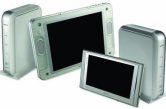

RESEARCH FROM THE INTERNATIONAL INFORMATICS
INSTITUTE
© 1995-2006 International
Informatics Institute, Inc. Some Rights Reserved.
This work is licensed under a
Creative Commons License.
Read our privacy guidelines.
Home TV sets are going flat, digital, and high definition, but the big news comes in the array of new features for managing programming, creating our own TV shows, and integrating all of our digital entertainment.
By Julie Brumlik | August 20, 2009
In the U.S., 248 million televisions are installed in 108 million homes reaching 94% of the adult population. In the 1980s, new technology — specifically cable and satellite delivery — dramatically increased the number of programs and channels offered. In the 1990s, DVD optical disk and Internet streaming media added to the home media experience. In the 2000s, flat panels, digital TV, Personal Video Recorders and High Definition Television increased the quality of the image and handed more control to the viewer. The digitization of TV melts the border between consumer electronics and information technology, making the home the next IT battleground.

The latest Sony WEGA TV is
wider
than the MiniCooper sports car. Giant flat digital TVs have
replaced bulky CRT (cathode ray tube) televisions in millions of households
and driven the price of a home set up into the $4,000 to $5,000 range. Plasma
screens and LCDs (liquid crystal displays) dominate today, but DLP (digital
light processing), LCoS (liquid
crystal on silicon), FED (field
emission display), SED (surface-conductor
electron-emitter) and OLED (organic
light emitting diode) displays that are brighter, sharper, bigger and
maybe someday cheaper are poised to compete.
Watching TV is getting so complicated you need a computer, and Microsoft's Windows XP Media Center Edition running on hot PCs like this Dell at left help organize your home's digital assets — live TV feeds, stored digital video and audio, digital photgraphy and video games. The link between the PC and the home TV set has always been tricky; the Media Center may be too much integration for most people, although the vision of total media control is attractive.
 Cable
and satellite programmers bless us with hundreds of channels of broadcast
content; we snatch some programs to disk on our TiVo PVRs; we buy hundreds
more DVDs and make our own home movies; and we download gigabytes of video off
the web. Electronic Program Guides likes the one in
Interact-TV's Telly media
server help us find what we want, but until we have
global standards and intelligent XML
content coding, most of the TV we're fed will be unfindable.
Cable
and satellite programmers bless us with hundreds of channels of broadcast
content; we snatch some programs to disk on our TiVo PVRs; we buy hundreds
more DVDs and make our own home movies; and we download gigabytes of video off
the web. Electronic Program Guides likes the one in
Interact-TV's Telly media
server help us find what we want, but until we have
global standards and intelligent XML
content coding, most of the TV we're fed will be unfindable.
 Placeshifting
transmits your home TV over the Internet to wherever you are in the world. We get
TV signals from broadcast towers, cable TV systems and DBS (direct brodcast
satellite) antennas. Now, Sony has introduced another channel: WiFi or 802.11
wireless Ethernet. Sony's 12 inch and 7 inch LCD
LocationFree TV
receivers at left link to base stations plugged into the home
entertainment network to click through TV channels, watch DVDs and surf the
while out by the pool, on the front porch or in China.
Placeshifting
transmits your home TV over the Internet to wherever you are in the world. We get
TV signals from broadcast towers, cable TV systems and DBS (direct brodcast
satellite) antennas. Now, Sony has introduced another channel: WiFi or 802.11
wireless Ethernet. Sony's 12 inch and 7 inch LCD
LocationFree TV
receivers at left link to base stations plugged into the home
entertainment network to click through TV channels, watch DVDs and surf the
while out by the pool, on the front porch or in China.
Ultimate control over home media comes with creation. New digital video authoring and editing tools and an explosion in home DVD recorder sales promises to make every consumer a TV producer, whether it's shooting new content with a DV cam, recording opportunistic video on a mobile phone, or re-editing and sampling recorded programs produced by Hollywood.
Mobile Video Magazine — industry statistics
Ultimate AV — product reviews
VideoHelp — hobbyist site for creating DVDs and oher optical formats
NielsenWire — consumer mobile video statistics
IN3's Pervasive TV Project examines the transformation of the home video landscape by power-shifting technologies:
Will home TV programming become portable (e.g. viewer profiles, WiFi access, mobile home server links)?
FREE
WEBCAST
IN3's research into the
development of video culminates
with our first Pay-Per-View webcast seminar.
Five Platforms examines all the places where video lives and paints
the big picture about television's future.
Learn more or ...
See the Driving Directions for a full list of features.
WATCH THE 90
SECOND TRAILER
ON YOUTUBE.COM